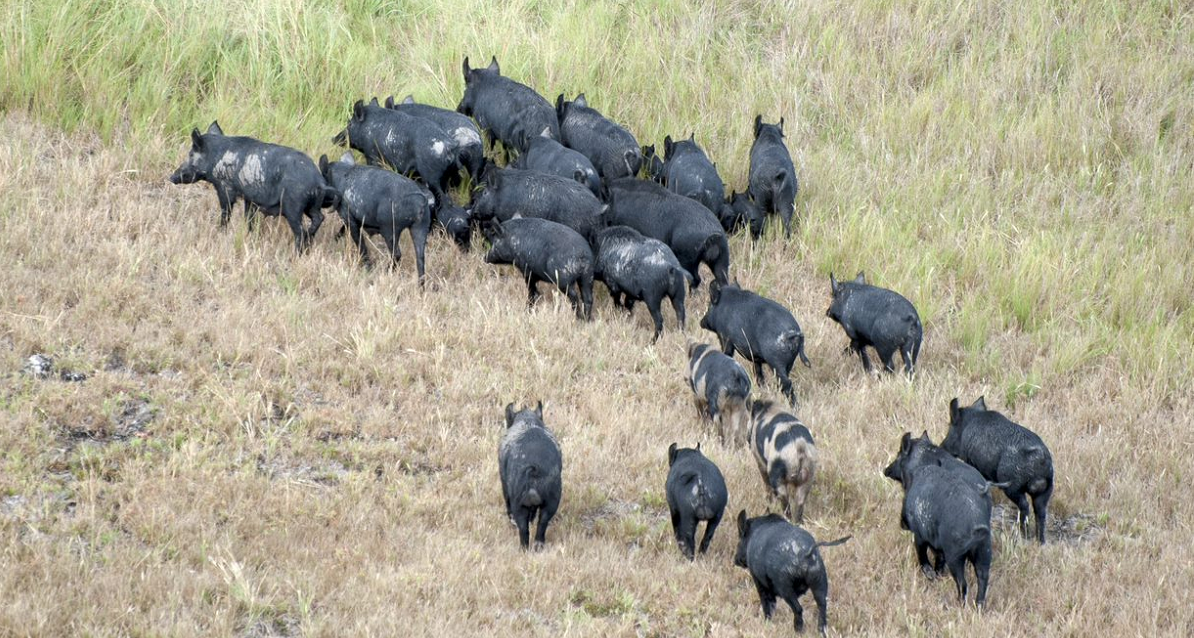Intensive Pest Control Zones
In NSW, Local Land Services is the lead agency in the delivery of invasive pest management programs working collaboratively across private and public land with a focus on ensuring land managers have access to appropriate information and best practice control options.
Now is the ideal time for coordinated pest management following successive good seasons and the current risk of foot-and-mouth disease. Under normal seasonal conditions, feral pig populations increase as much as 85% per year without intervention by land managers.
Intensive Pest Control Zone Program
Following the NSW Government’s announcement of $65 million in additional investment in emergency animal disease prevention, Local Land Services has been given the responsibility of delivering a $22.83 million Foot-and-Mouth Disease (FMD) Prevention and Preparedness Program. Cloven-hoofed pest animal control programs are a particular focus for this investment, including feral pigs, wild deer and unmanaged goats.
Land managers and Local Land Services need to continue to work together to ensure we protect primary production and native animals from exotic diseases like FMD so we are piloting a pest control program that targets selected zones for intensive control activities.
This program is in addition to our existing pest animal control programs which we will continue to deliver throughout the year.

What are Intensive Pest Control Zones?
Intensive Pest Control Zones are areas in which a range of pest control activities and approaches will be implemented to reduce the population of cloven-hoofed pest animals (feral pigs, wild deer and unmanaged goats) to levels that reduce the likelihood of transmitting FMD.
What are the benefits of Intensive Pest Control Zones?
- They provide a good test of different approaches to controlling pest animals in the event of a disease outbreak. Comparing the different approaches will give us great insight into how to be better prepared and how to deploy our programs quickly should an emergency animal disease outbreak occur.
- This program will identify shortcomings, challenges and successes in the capacity to respond across NSW to an outbreak at this scale. We will be able to compare the pest control methods with each other to determine which have the biggest impact.
- We will also inform our business-as-usual control programs so we can have the biggest impact on pest animals year on year.
How will the Intensive Pest Control Zones be managed?
- Surveying sites for pre-control cloven-hoofed pest populations using a variety of established monitoring techniques such as thermal imaging and distance sampling.
- Landholders in these zones will be notified and invited to participate in the pest control program.
- Control methods suitable to the location including aerial and ground shooting, baiting and trapping, will be implemented.
- Capacity building activities will be delivered for landholders so they can implement control programs themselves in the future.
- The duration of the control activities in the zones will depend on seasonal conditions, available contractors, and Local Land Services resources.
Why have we selected these zones?
- We have selected zones where the size of the area is logistically feasible. Local Land Services needs to be able to deliver control programs in the zones with the finite resources we have available.
- Consideration has been given to the value of production and conservation assets in the selected zones.
- We have selected zones where we know there are significant pest populations based on previous control programs and reports directly to Local Land Services.
- Due to the short timeframes for this program, consideration has been given to properties that have previously been involved in control programs as the appetite for additional programs is higher. These stakeholders have had exposure to programs before (particularly aerial/ ground programs).
Is this program going to create an excess of dead animals for predators like wild dogs, which would contribute to their population growth?
No – we are still delivering our existing pest control programs for non-cloven-hoofed animals such as wild dogs, foxes and rabbits, to manage their populations.
Why is it important to control cloven-hoofed pests in an FMD outbreak?
- If FMD is confirmed in an area it is vital to reduce susceptible pest species (cloven-hooved vertebrates) to limit the spread of the disease. The role played by feral susceptible species in virus transmission is largely determined by their population densities and level of interaction with domestic susceptible species.
- Reducing the population of cloven-hoofed vertebrate pests reduces the risk of ongoing transmission in infected areas during an outbreak.
- Reducing transmission is key to rapid eradication and reopening our export markets.
Should I be worried about an FMD outbreak?
FMD has not been detected in Australia. This program is about getting NSW better prepared to respond to FMD if it was detected.
Livestock producers must be alert for signs of disease in their animals. If animals are showing signs of illness that are consistent with FMD, this must be reported as a matter of urgency to a Local Land Services District Veterinarian, the Emergency Animal Disease Watch Hotline on 1800 675 888 or to your private veterinarian. Landholders should familiarise themselves with the signs and symptoms of Foot and Mouth Disease in livestock.
All livestock owners should have stringent biosecurity measures in place on their property, and now is the time to get a Farm Biosecurity Plan in place. Local Land Services offers a range of farm biosecurity advice and resources.
How can I get involved in pest control programs?
Contact your Local Land Services invasive species team on 1300 795 299.